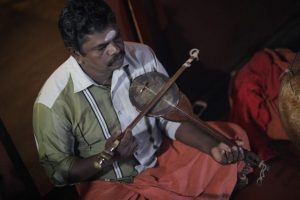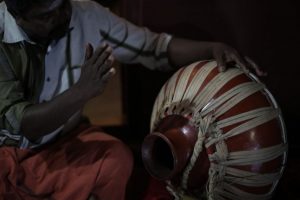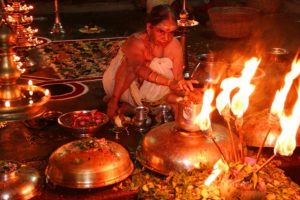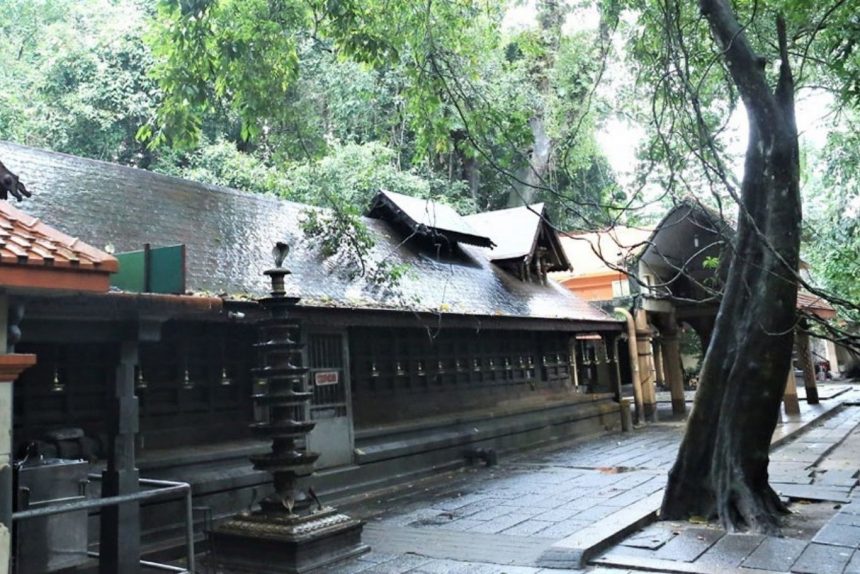Worship of Nature is ingrained in the culture of Kerala. The indigenous communities revere the Sun and the planets, the forests, the rivers, the land and the Ocean. Vedic sciences such as Astrology and Ayurveda are based on the influence of environment and ecological balance on the harmonious coexistance in the Universe. It is believed that, based on existing constellation at the time of one’s birth, specific tree/plant and animal/birds have influence on the life of human being. Ancient practices such as circumambulation of Banyan tree and holy basil, chanting of hymns and, planting of trees at the cremation site are still being followed
The sacred groves are patches of green ecosystems which shelter exotic flora, and fauna, including ferocious snakes and various other reptiles. Local people consider Snakes as messengers of mythical and divine serpents, and therefore sacred groves are revered as places of worship of serpents.
The divinity of sacred groves is preserved by performing appropriate rituals regularly and they are protected by the local communities from being encroached or destroyed. The society upholds the sanctity of the sacred groves, and abstain from activities which disrupt the harmony of this rich ecosystem, as the faith is deep rooted in the minds of the local people.
Rituals in Sacred groves
 Pulluvan Paaattu – Ritual
Pulluvan Paaattu – Ritual
Pulluvar is a community in Kerala, whose livelihood is reciting specific hymns (Paattu) which have the power to invoke serpent deities for seeking blessings from the worshipers. They themselves craft the musical instruments to be played along with these recitals.
The instruments which the Pulluvar use are Veena, Kudam, and Ilathalam. The veena is a single-stringed fiddle made of soft-wood which is covered using the skin of monitor lizard. The Kudom is a mud pot, having the mouth closed using leather. It amplifies the sound of the string attached to it with the help of a bamboo piece and a specially crafted stick. The string is made of two twisted leather thongs. The performer holds this pot to his left and the string is plucked with a plectrum. Ilathalam is symbol made of bronze. Each of these musical instruments symbolises the mythological Gods, Brahama, Vishnu and Shiva respectively.
 The recital of the Pulluvan Paattu is one of the ancient rituals being followed for devotees to communicate with the mystical King of serpents – Nagaraja and the other serpent gods. The Pulluvan (male) and the Pulluvathi(female) recite the songs which can invoke the divine spirit and thereby seek the blessings for the devotee who is offering the Paatu.
The recital of the Pulluvan Paattu is one of the ancient rituals being followed for devotees to communicate with the mystical King of serpents – Nagaraja and the other serpent gods. The Pulluvan (male) and the Pulluvathi(female) recite the songs which can invoke the divine spirit and thereby seek the blessings for the devotee who is offering the Paatu.
 Even today, on auspicious occasions devotees offer Pulluvan Paattu in Sacred groves. In rural areas Pulluvar are invited to houses to present the Pulluvan Paatu on special occasions such as child birth, weddings and house-warming or as thank giving for good harvest, success in ventures etc. They render the songs praising the serpent deities and narrating glorious stories from the epics such as the birth of 1000 serpent sons of the wife of a sage, the encounter between Krishna and Kaliya and the story of the mythological serpent Anantha, the recliner of Lord Vishnu.
Even today, on auspicious occasions devotees offer Pulluvan Paattu in Sacred groves. In rural areas Pulluvar are invited to houses to present the Pulluvan Paatu on special occasions such as child birth, weddings and house-warming or as thank giving for good harvest, success in ventures etc. They render the songs praising the serpent deities and narrating glorious stories from the epics such as the birth of 1000 serpent sons of the wife of a sage, the encounter between Krishna and Kaliya and the story of the mythological serpent Anantha, the recliner of Lord Vishnu.
Pulluvar are good at prophesying based on the calls of the bird of omen, ‘Pullu’.
Noorum Palum – Ritual
Noorum palum is considered as the favorite feed of the serpents. It is a mixture of turmeric powder, rice flour, milk, tender coconut, and banana.
 Sarpa bali – Ritual
Sarpa bali – Ritual
Sarpa bali is the ritual of symbolic feeding of the serpent deities. This ritual is performed to get rid of misfortunes in life and get healed from snake bites. This ritual, which is usually performed after dusk, involves invoking the serpent gods to the Kalam by chanting and offering a mixture of rice powder, milk, banana, coconut and turmeric.
Sarpam Thullal – Ritual
Sarpam Thullal is a ritualistic performance offered by the devotees to invoke the serpent gods and seek the blessings. The members of the Pulluvar community perform this ritual.
 The ritual begins with a colourful drawing (Kalam), featuring the five hooded Nagaraja. Two girls are made to sit in front of the Kalam and songs for invoking the serpent gods are sung by the Pulluvar to the accompaniment of Veena, Kudom and the Ilathalam. As the songs progress the girls get into trance and begin to make frenzied movements like serpents. Getting possessed by the divine spirit they make prophecies which come true very often. The ritual concludes by wiping off the Kolam using the bunches of coconut flowers and blessing the devotees.
The ritual begins with a colourful drawing (Kalam), featuring the five hooded Nagaraja. Two girls are made to sit in front of the Kalam and songs for invoking the serpent gods are sung by the Pulluvar to the accompaniment of Veena, Kudom and the Ilathalam. As the songs progress the girls get into trance and begin to make frenzied movements like serpents. Getting possessed by the divine spirit they make prophecies which come true very often. The ritual concludes by wiping off the Kolam using the bunches of coconut flowers and blessing the devotees.
Natural colors are used to draw the Kalam. Green symbolises fertility and is made by crushing leaves of Gulmohar and bead tree. Rice flour is used to make the white colour symbolising purity. Black symbolises strength and is made by burning rice chaff and powdering charcoal. Turmeric powder is used for yellow color -the color of faith. Red represents anger and is made by mixing turmeric powder and lime.
The Pullover community carries forward their tradition with utmost reverence even though the returns from service is not sufficient to make both ends meet.
The sacred grove ‘Mannarassala’
 The history of Mannarassala
The history of Mannarassala
Mannarassala, a rural village at lower altitude than the sea level in Alleppey, is one of the ancient sacred groves of Kerala, that is mentioned in many of the mythological stories, epics and manuscripts.
The legend is that the creator of Kerala – the Yogi- Parasurama-had discovered this green grove which was then surrounded by the Mandara trees, during his expedition to set up liveable villages across the land that he had reclaimed from the Sea.
He considered this grove as the abode of Nagaraja- the mythological Lord of serpents. With the help of the Brahmin community accompanying him, tantric rituals were performed, and consecrated Nagaraja, Nagayakshi as well as their associates. He prayed for the blessings for converting the reclaimed saline uninhabitable land into a prosperous green habitat for his fellow men.
The generations of the brahmins whom Parasurama had brought to inhabit the land stayed back, carrying forward the legacy of the sage, taking care of the sacred grove and performing the rituals promptly. It is believed that when a dreadful forest fire broke out many of the serpents were killed and many were seriously injured with the burns. At that time a kind couple of the family took care of the injured serpents, treating them with turmeric, milk honey and tender coconut water and cooling the surroundings by watering the soil. Very soon the couple, who had been in grief over not having children for several years, were blessed with a child.
The unexpected joy that they received out of blue had deepened their faith in Nagaraja and with utmost gratitude the wife started taking care of the rituals of the sacred grove. Her experience had spread around through word of mouth and thus Mannarassala became famous. People from different walks of life from far and wide make a visit in the temple at least once in a life time seeking blessings for the harmony in life.
Mannarassala is the only place of worship in Kerala where a woman is bestowed with the responsibility of performing the rituals of the temple.
Following quite rigid discipline in lifestyle and dedicating to performing the rituals, the priestess acquires the wisdom to protect the temple and the environment. On auspicious days, she has the privilege to carry the idol of Nagaraja during the spectacular procession to the Illom-the ancestral home of the care takers of the temple.
One of the most popular offerings in Mannarassala is Uruli Kamizhthu, by couples suffering from infertility issues. Uruli is a brass vessel being used traditionally for cooking. The couple who are facing issues ceremoniously dedicate an Uruli to the temple. The priestess gives some specific herbal medicine to the couple and suggests the prayers to be chanted daily. The priestess keeping the Uruli upside down inside the cellar where the divine spirit is supposed to be present, she performs specific rituals and pray to Nagaraja to bless the couple with child.When the couple get blessed with child they come back to the temple to attend the thanksgiving ritual, and the Uruli will be turned up. Kalam drawing, Pulluvar Paatu, Sarpa Bali and Noorum Paalum offering are regular rituals in Mannarassala as well.
Sarpam Paattu – An offering of a lifetime – Ritual
The ritual that pleases the serpents most is Sarpam Pattu. Performed only once in 40years, this sacred ceremony is quite special and the rituals are complicated in terms of expenditure, manpower and time. Six to seven unmarried Brahmin ladies have to take part in the rituals along with the Preiestess.
The rituals which may last for many weeks until the Priestess becomes divinely possessed and announces that the Nagaraja, Sarpa Yakshi, Naga Yakshi, Naga Chamundi, Nilavara Muthassan, Kuzhi Nagam, Kari Nagam, Mani Nagam and Para Nagam are pleased with all the rituals and the offerings. The altar of the sacred ritual become mystical with the colourful Kalam, the hymns, the dance and the feeding ritual – Noorum Paalum.
Pallippana – Ritual
Pllippana is a ritualistic performance to be conducted one year after the Sarapa Paattu ceremony. This rendition of very specific songs to entertain serpentsdone by Pulluvar, while the Priestess performs rituals at the Kalam.
The sustainablity of the sacred groves is at check with Urbanisation and it looks as if mysticism and modernity have to go hand in hand to save our rich eco-system.
How does one experience the Sacred Groves of Kerala ?

As you cruise with us onboard RV Vaikundam, experiencing the 7nights’ exploration of the rural culture of Kerala, you get the rare chance to visit the sacred grove – Mannarassala and watch the tantric rituals and the sanctury of exotic flora and fauna that it preserves.
RV Vaikundam offers an expedition form of cruising on the Backwaters of Kerala. RV Vaikundam is a 9 cabin (1 Deluxe Cabins and 8 Superior cabins) motor vessel offering a seven-night eight-day rendezvous, from October to April.
On day 2 of the 7 night North-South Cruise we visit the village spending time with the coir weavers, the shell harvesters and farmers, engaging in conversation with them about the riparian life, and watching various indigenous techniques of fishing. Coir, one of the major exports of Kerala, is of much relevance today than ever before when plastic has become a global menace. People of Chenganda are major suppliers of this cottage industry.
The 7 night North-South Itinerary starts at Kochi and ends in Alleppey in the State of Kerala, while the 7 night South-North Itinerary starts from Alleppey to Kochi in the State of Kerala. Airport connectivity is available at Kochi. All inclusive price starts from USD 250* per person per night for base category cabins. *Terms and conditions apply.
The Itinerary is subject to weather and river conditions or if we are faced with any political challenges. The tourism season is from October to April.

















Leave a Reply
You must be logged in to post a comment.